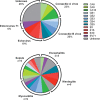Severe Enterovirus Infections in Hospitalized Children in the South of England: Clinical Phenotypes and Causative Genotypes
- PMID: 26882165
- PMCID: PMC4985250
- DOI: 10.1097/INF.0000000000001093
Severe Enterovirus Infections in Hospitalized Children in the South of England: Clinical Phenotypes and Causative Genotypes
Abstract
Background: Most enterovirus surveillance studies lack detailed clinical data, which limits their clinical usefulness. This study aimed to describe the clinical spectrum and outcome of severe enterovirus infections in children, and to determine whether there are associations between causative enterovirus genotypes and clinical phenotypes.
Methods: Retrospective analysis of microbiological and clinical data from a tertiary children's hospital in the South of England over a 17-month period (2012-2013).
Results: In total, 30 patients were identified, comprising sepsis (n = 9), myocarditis (n = 8), meningitis (n = 8) and encephalitis (n = 5). Cases with sepsis or myocarditis were significantly younger than those with central nervous system disease (median age 21 and 15 days vs. 79 days; P = 0.0244 and P = 0.0310, respectively). There was considerable diversity in the causative genotypes in each of the clinical phenotypes, with some predominance of echoviruses in the meningitis group, and coxsackie B viruses in the myocarditis group. Thirteen cases required mechanical ventilation, 11 cases inotropic support, 3 cases dialysis and 3 cases extracorporal membrane oxygenation. The overall mortality was 10% (sepsis group, n = 1; myocarditis group, n = 2). Of the survivors, 5 (19%) had long-term sequelae (myocardial dysfunction, n = 2; neurological sequelae, n = 3). Patients with encephalitis had the longest hospital stay (median: 16 days), compared with 9, 6 and 3 days in patients with myocarditis, sepsis and meningitis, respectively (P = 0.005).
Conclusions: Enterovirus infections, particularly enteroviral myocarditis and encephalitis, can cause significant morbidity and mortality. The results show that there are currently no strong associations between clinical phenotypes and particular causative enterovirus genotypes in the South of England.
Conflict of interest statement
The authors have no conflicts of interest to disclose.
Figures


References
-
- Pallansch MR, Oberste MS, Whitton JL. Enteroviruses: polioviruses, coxsakieviruses, echoviruses, and newer enteroviruses. In: Knipe D, Howley P, editors. Fields Virology. 6th ed. Philadelphia, PA: Lippincott Williams & Wilkins; 2013. pp. 490–530.
-
- Tebruegge M, Curtis N. Enterovirus infections in neonates. Semin Fetal Neonatal Med. 2009;14:222–227. - PubMed
-
- Centers for Disease Control and Prevention (CDC) Nonpolio enterovirus and human parechovirus surveillance - United States, 2006–2008. MMWR Morb Mortal Wkly Report. 2010;59:1577–1580. - PubMed
-
- Dagan R, Jenista JA, Menegus MA. Association of clinical presentation, laboratory findings, and virus serotypes with the presence of meningitis in hospitalized infants with enterovirus infection. J Pediatr. 1988;113:975–978. - PubMed
-
- Tseng FC, Huang HC, Chi CY, et al. Epidemiological survey of enterovirus infections occurring in Taiwan between 2000 and 2005: analysis of sentinel physician surveillance data. J Med Virol. 2007;79:1850–1860. - PubMed
Publication types
MeSH terms
LinkOut - more resources
Full Text Sources
Other Literature Sources
Medical

